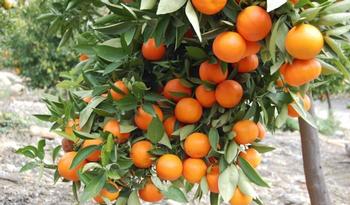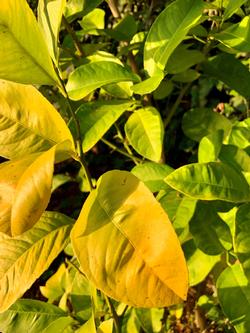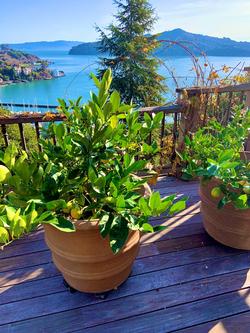Winter citrus care
-
James Campbell
-
 We can grow many kinds of citrus in Marin but they may need special care in our winter months. Photo Credit: UC Regents
We can grow many kinds of citrus in Marin but they may need special care in our winter months. Photo Credit: UC Regents
When I was a kid, my Dad told me the leaves of our citrus tree turned yellow in the winter to remind us it grew lemons. That did not explain why it also happened to the kumquat tree!We can grow many kinds of citrus in Marin, but it can be challenging. Winter is the time of year we harvest our citrus bounty, but it is also the time we need to take the most care. Cold and too much water are the biggest problems for our citrus.
Those yellow leaves are chlorosis, and most likely indicate a lack of nitrogen. Nitrogen is a mobile nutrient so when there is a shortage, a plant can move the nitrogen from one part of the plant to another. The new growth on your citrus can be green and healthy, but the old leaves are pale and yellow green. This means the tree has moved the nitrogen from the older leaves to support the growth of the newer leaves. If the nitrogen deficiency gets worse, leaves throughout the plant turn more yellow. If it gets really bad, the leaves will turn brown and fall off the tree. Compost is a great way to add nitrogen to your soil. Chlorosis is common in citrus trees when there is a lack of nitrogen in the soil or it is too cold and wet for the plant to uptake nitrogen.
Chlorosis is common in citrus trees when there is a lack of nitrogen in the soil or it is too cold and wet for the plant to uptake nitrogen.In the winter, chlorosis can happen even if there is adequate nitrogen in the ground. It turns out when the soil is cold and wet, citrus cannot take up the available nitrogen. When the warm weather returns, the nutrient uptake should resume. In the meantime, you can apply foliar nitrogen such as urea to help increase bloom set and fruit yield.
Citrus trees do not like to sit in water. During a wet winter, we can’t turn off the rain, so it is crucial when planting new trees that you choose a spot with good drainage. If you have clay or compacted soil, it is wise to either plant in raised beds or in a container or amend your soil to create better drainage before planting citrus in the ground.
If your citrus is already planted, add compost, but keep it away from the trunk. The compost improves the soil structure and will help with drainage. Clay soils have a poor structure for two reasons. They tend to be low in organic matter and their mineral particles have a fairly uniform size. In good soil, different molecules tend to glom onto one another, forming aggregates. These are small, irregularly-shaped particles or clumps. This clumping of material opens spaces or channels between the aggregates. Space allows air to circulate and water to drain. If you have clay or compacted soil consider growing citrus in a container. These pots are on wheels so they can follow the sun throughout the year.
If you have clay or compacted soil consider growing citrus in a container. These pots are on wheels so they can follow the sun throughout the year.If a frost or freeze is in the forecast, it is essential to protect your citrus. Make it a point to keep your plants well-watered before a cold snap. Drought-stressed trees are more susceptible to frost damage. Many people recommend stringing Christmas tree lights in the tree. This works great if you can find the old-fashioned lights. Modern lights and LEDs do not cast the same warmth. A 100-watt outdoor lamp will also work, be sure to place near the center of the tree.
Cover the tree to protect them. Use wooden stakes and make a canopy of blankets, bedsheets, drop cloths, or canvas. If you must use plastic, make sure the plastic does not touch the foliage. Using the lights and the covers should do the trick. Remove the coverings when temperatures rise the next day.
If there is a significant freeze, be sure to remove the damaged fruit. If damaged fruit remains on the tree, it could decrease future fruit yield. Do not prune frost damage to branches until after the danger of frost has passed for the season.
Citrus are heavy feeders. Start fertilizing in February, then continue every four to six weeks until the start of September. Common citrus pests include whiteflies, thrips, and mites. Check your citrus foliage for insect eggs. Spray with Neem oil or another biological insecticide if necessary.
For more tips on managing your citrus garden, go to marinmg.ucanr.edu.



